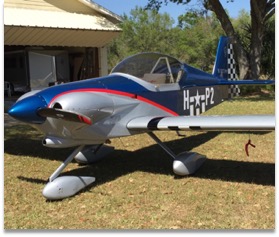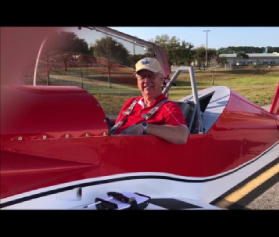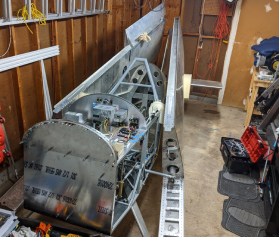Flight testing continues on the Panther with over 27 hours of flight time showing on the hobbs. To date, the Panther has shown no bad habits or traits. It is predictable and easy to fly, goes where you point it and with the 100-110 HP Corvair performs like an aircraft with more horsepower. For a LSA conforming aircraft, it has the underlying genes of a higher performance aircraft.
The mission for 13 May was to continue to build time and get to the 40 hour bench mark. The sortie departed Haller Airpark at 6 PM with a slight wind out of the West. Fuel load was 16 gallons and temperatures in the mid 70’s. Several fellow RV 4 pilots agreed to join the flight and a general match of aircraft performance with some in trail formation aerobatics were planned. Both RVs were equipped with Lycoming 180 HP engines with fix pitch props. After a quick join up at 3500 feet AGL some basic wing formation was completed with the Panther easily maintaining a cruise speed of 150 MPH at 2850 RPMs. After some wing work an in trail formation was established and with the Panther power set at 2850 a series of gentle aerobatics entered. The RVs where able to easily match banks and airspeed with some necessary power adjustments in the vertical. With the Panther power set at about 65% the airspeed bled off fairly rapidly in the vertical. The aircraft is very fluid and easily matches roll and turn rates of the RVs.
After about 10-15 minutes one of the RV departed for home base which left my neighbor in his RV-4 in the formation. The driver of this RV is a highly experience retired Navy attack pilot with lots of hours in A-7s and A-6’s. This combination allowed for a more aggressive maneuvering program to see how the Panther handled some high G input. The trail aircraft was wearing a wing mounted GoPro and obtained some excellent footage of the flight.
Immediately the turn capability was demonstrated with some 2.5-3.0 G loops. The RV was able to match the vertical turn to the inverted position. It was taking the RV up to 4Gs to match the rate of pull. At the top the Panther just pulled its nose down and through and accelerated away from the RV. After two loops the RV was losing ground and required more and more Gs to try to stay in position. The formation transitioned into some high G level turns and a 100 MPH was entered. Once again the light wing loading (in the 10’s) resulted in the RV having to be in the 4 G range to try to stay to the inside of the turn. Even then the RV was losing ground rapidly. The Panther could hold its own in both vertical and turning events and could easily go from 70 to 170 MPH. Several times I demanded more turn than the Panther was capable of and it advised with a sharp rumble in the after part of the aircraft. I noted that the airplane had no tendency to depart or drop a wing. It just rumbled and kept on flying; excellent manners. A sidebar was that with the power being maintained at a near constant setting the engine temperatures remained well within tolerances. The highest CHT seen was 405 on the #4 cylinder and oil temperature of 219. Cooling has been easily controlled with no tendency to get hot even during low-speed and high angle of attack events.
The flight ended with a 360 overhead approach with the Panther in the lead. Turn rates for pattern work was very compatible with the RV and a wheel landing was made with airspeed’s of 75 MPH maintained on final. Those slightly higher speeds resulted in a 900 foot landing roll on grass with no brakes.
The Panther continues to perform, in all aspects, with predictable and smooth handling qualities. A spirited LSA that has exceed my expectations.
– Bob Woolley, Ret. Air Force Pilot and Panther Sport Beta-Builder
The following video is of two different flights. We have one flight with in-cockpit views and another from the wing of a fellow RV-4 pilot. You will also see a third RV-4 in some of the footage.



